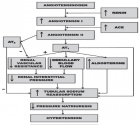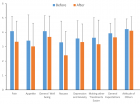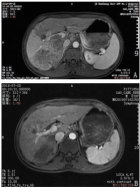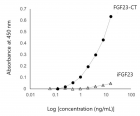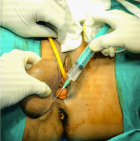About Kayseri Education and Research Hospital
Kayseri Education and Research Hospital
Articles by Kayseri Education and Research Hospital
Place of beta-radiation in the etiology and treatment of cataract
Published on: 9th February, 2018
OCLC Number/Unique Identifier: 7355970716
Among eye diseases, cataract is the most commonly encountered lens disease and the leading cause of reduced vision. Cataract caused by radiation develops due to neck & head, central nervous system tumors, eye localized tumors and total body irradiation. Today, the only treatment of cataract is surgery.
Beta radiation is seen to have an important place both in the etiology and treatment of cataract. Beta-radiation creates cataract in the lens as an adverse effect. However, beta radiation implementation is used for delay or prevention of cataract in glaucoma surgery. Effects of beta-radiation on the etiology and treatment should be supported by further prospective clinical studies.
Adrenal insufficiency in Bilateral Adrenal Metastasis implemented SBRT
Published on: 14th February, 2018
OCLC Number/Unique Identifier: 7347067597
Today, there is a considerable increase in localizing adrenal bulks with the bringing radiologic diagnosis methods having high technology into use and improvement in diagnostic tests. Adrenal glands are vital tissues for the organism due to the hormones they secrete. Death is a natural result in the absence of adrenal cortex. Adrenal bulks can be seen with different clinical, laboratory and radiological data. These bulks are often benign and rarely malign. They can be functional or non-functional. Major treatment methods used fort he treatment of adrenal gland primary tumors or metastases are surgery, arterial embolisation, chemical ablation, radiofrequency ablation and radiotherapy [1-4].
Adrenal glands are one of the metastatic fields. In wide autopsy series, adrenal metastasis has been determined between the rates of 13-17% [5]. While unilateral metastasis is common, bilateral metastasis’ rate of incidence is between 4-20%. It has been stated that lung (35%), gastric (14%), esophageal (12%) and hepatobiliary (10%) primary carcinomas adrenal metastasis are prevalent most frequently [2]. Curative treatments are tested on patients having cancer with oligo metastasis limited with adrenal gland and primary source is under control because of the expectation of long-term survival, and the surgery is the first choice. These bulks can be treated with open and laparoscopic surrenalectomy in a curative way. It was reported in studies that overall survival was longer in resection of clinically isolated adrenal metastases when compared with nonsurgical therapy (including RFA, external beam radiotherapy, arterial embolization, radioembolization, chemical ablation, and cryoablation) [1,2,5,7]. Lo et al., found one-year survival as 73% and two-year survival as 40% in their study conducted on 52 patients having curative resection for solitary adrenal metastasis [3]. Tanvetyanon et al., demonstrated 5-year survival rates of 25% following resection of isolated synchronous adrenal metastases and reported 26% after resection of metachronous adrenal metastases in their study conducted on NSCLC patients developing solitary adrenal metastasis [4]. Conducted studies revealed that the rate of complication was 9-20% in patients having adrenalectomy for solitary adrenal metastasis [2-4,7].
In recent years, the use of radiotherapy, which is a treatment modality as effective as surgical resection, has become prevalent for the management of oligometastases. Today, three different modalities have been tested in the radiotherapy treatment of adrenal gland metastases. In the first one, total 50 Gy treatment dose with 3D-CRT as daily 2 Gy fraction dose is given [8]. The second one is IMRT implementations for adrenal gland metastases but it isn’t thought as suitable according to Practice Guidelines for Neuroendocrine Tumors published by NCCN in 2010. The third radiotherapy modality is stereotactic body radiotherapy (SBRT). SBRT implementations have started to be preferred today since they are completed in a few fractions in addition to that they show close results to surgery for primary tumors and metastases. Holy et al., implemented SBRT to patients having 13 solitary adrenal metastases with NSCLC at 5 fractions and between 20 and 40 Gy total doses. They found disease-free survival as median 12 months, overall survival as median 23 months and local control rate as 77% [9]. In SBRT implementations for different cancer types determined 30 adrenal metastases, Chawla et al., reported the rates of one-year survival, local control and distant metastasis as 44%, 55% and 13% respectively [10]. In Casamassima et al.,’s study on this issue, the rate of two-year local control was found as 90% [11]. Second degree toxicity was seen in none of the above mentioned studies according to the RTOG toxicity classification. Wardak et al., reported that the patient having lung cancer that they implemented SBRT for bilateral adrenal metastases developed adrenal insufficiency depending on SBRT [6]. Ippolito et al., Reported that adrenal insuffiency may be due to both the tumor and the local treatment [12]. Incidence of symptomatic adrenal insufficiency were reported 4% [2,13]. Casamassima et al and Onishi et al studies, two grade 2 adrenal insuffiencies were reported [11,14].
Consequently, when all these data were evaluated, it is seen that SBRT use has gradually become prevalent for patients not suitable for surgery because of comorbid disease, for patients having oligometastatic cancer that are not suitable for surgery since it has vital risk to resect or that refuse surgery. However, it hasn’t been clear yet that local control will be provided with how many total doses and which fraction schema. There is no agreement on the examination of the adrenal hormone axes because of the short length of life. Besides, it should be kept in mind that adrenal insufficiency can develop in patients implemented SBRT because of bilateral adrenal metastasis developing as synchronous or metachronous. The hormone levels of these patients need to be followed. More researches should be done to lighten this matter.
Which is the best? Palliative Radiation Therapy to Spleen or Splenectomy
Published on: 9th February, 2018
OCLC Number/Unique Identifier: 7347023873
Spleen is one of the most important organ of the reticuloendothelial system and coordinates the immune response. Splenectomy is performed for hypersplenism, and staging of hematological malignancy. In conservatively followed patients, radiation therapy can be used to reduce hypersplenism symptoms. Splenectomy or palliative radiotherapy to spleen may probably cause an immune suppressive condition. This may probably local and systemic complications.
Autologous grafts in radiotherapy received breast cancer patients
Published on: 9th February, 2018
OCLC Number/Unique Identifier: 7347013999
German surgeon, Vincenz Czerny, transplanted a patient’s own lipoma located in the hip to it’s breast after gland excision due to mastitis in 1895. Dr. Vincenza reported that for at least a year he didnt observe any problem on the operated breast [1]. Injection of adipose tissue to the breast has been used in breast cancer patients during breast reconstruction and lumpectomy. And in cases of revision autologous tissues are used for reconstruction. In clinical practice, many breast cancer patients apply to the clinics mostly after radiotherapy for reconstruction. Rigotti et al used purified autologous lipoaspirates in breast cancer patients with late term complications of radiation therapy and observed increase in neovascularization and wound healing [2]. Panettiere and colleagues compared aesthetic and functional features of fat grafts in radiotherapy received breast cancer patients and control group. In the fat graft group, all clinical symptoms and aesthetic scores were significantly higher than the control group [3].
In plastic surgery especially after the surgical treatment of breast cancer, prosthetic techniques, various autologous flaps or combinations of both are performed for breast reconstruction. Particularly breast reconstructions following adjuvant radiotherapy have less success rates due to adverse effects of radiotherapy [4-10]. There are reports showing reduced complications rates with use of fat grafts before and after breast reconstruction with prosthesis in patients received radiotherapy after lumpectomy or mastectomy.
With that, in patients receiving radiotherapy after fat grafting, local complications such as fat necrosis, infection can be seen more [3,11]. It was reported that adipocytes may had paracrine and endocrine interactions with tumor cells and stromal elements [12]. The fat grafts used in breast cancer were thought to cause local recurrence, distant metastasis or development of new cancers; there was no relationship in the clinical series. There is aromatase activity in the adipose tissue. Thus, fat tissue is the main source of post-menopausal estrogen hormone. Tumor cells and surrounding tissue were found to be higher in aromatase activity. Therefore, when fat tissue is injected subcutaneous or under the gland rather than into the parenchyma local recurrence risk is low [2].
When fat tissue is injected to breast, a good physical examination and mammography should be performed. After fat injection, sometimes calcifications are formed as a result of undergoing necrosis and they interfere with malignancy. Therefore before and after the procedure, mammography must be taken for comparison and existing and or newly developed calcifications should be determined.

HSPI: We're glad you're here. Please click "create a new Query" if you are a new visitor to our website and need further information from us.
If you are already a member of our network and need to keep track of any developments regarding a question you have already submitted, click "take me to my Query."







